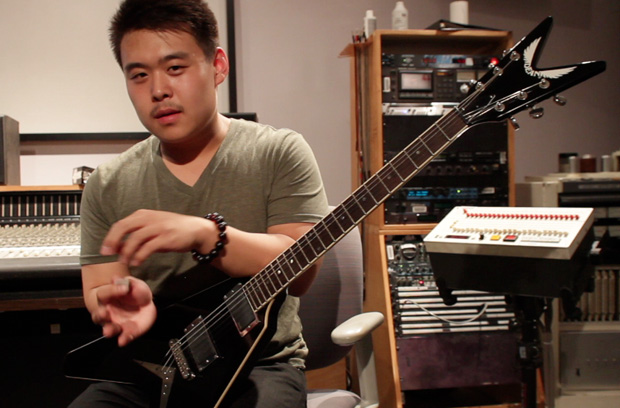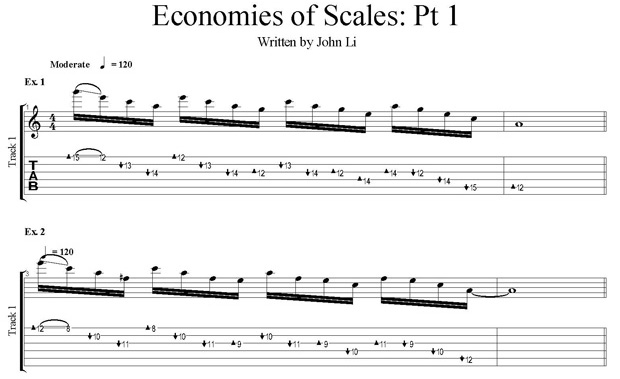
One aspect I’ve noticed many players overlook in their quest for “ultimate shred-dom” is the ability to control their instrument.
Now, I’m all about blazing through scales and sweeping like hell, but a gratuitous display of such can compromise the melodic development of a line.
And when we’re programmed to simply run up and down patterns while taking a solo, our lack of control can get the better of us when we run into speed bumps (pun -- sort of intended).
This is where economy picking comes into play. For those of you not too familiar with the technique, it’s when you keep the same picking motion when crossing strings. Rather than picking up your pick when switching to the adjacent string, you simply let it fall onto that string, providing a more natural transition.
In my experience, it not only smooths out the rough edges in your playing but allows you to think more melodically in terms of your soloing. For years I was stuck rehashing the same old ideas over and over and becoming frustrated with my lack of progress. One day I heard the story of Gypsy jazz guitarist Django Reinhardt and how he injured his left hand in a fire, allowing him to fret notes with only his middle and index fingers.
I decided to check out his music and was knocked off my feet by how fluid his playing was. I remember texting my guitar teacher at the time, telling him how I had “rediscovered music.” If the guy was able to do with two fingers what most of us couldn’t even dream of attempting with four, then I was definitely missing something.
Then one day I learned the secret to his fluidity — it was economy picking, and it got me excited about playing again. And while I admit I don’t use it exclusively, the technique lends itself to vast melodic possibilities while avoiding fretboard awkwardness.
All the latest guitar news, interviews, lessons, reviews, deals and more, direct to your inbox!
Now, they call it economy picking is because you’re conserving motion by not changing the pick’s direction. Therefore, your right hand demands more focus as you’re “economizing” its movement. You’re not only playing faster but smoother, and you’re able to gain more control as a player.
Many guitarists whose repertoires demand technical proficiency will often use this style of picking, as it’s a much more elegant alternative to, um, alternate picking.
Players ranging from jazz to metal, such as Frank Gambale, Django Reinhardt and Jeff Loomis, have all used it at one time or another. In fact, Gambale, who simply calls it “sweep picking” (It must be an Aussie thing), swears by it. The reason economy picking is a benchmark in modern guitar playing is that it forces you to play things you’re not used to, and are therefore more inclined to think your lines through.
When it comes to developing speed, one thing I will mention, which contradicts what most guitarists advise, is that you don’t necessarily need to start at an incredibly slow tempo. I remember practicing this way for hours with the monotonous click on my metronome annoying the hell out of my parents. When I got comfortable playing at a slow pace, I upped the tempo and began playing fast, only to be met with disastrous results. I soon discovered this is because you hold the pick differently when you play slow than when you play fast!
Picture the difference between running and jogging: While both require that you move your legs to travel a specific distance, you’re using different muscles for one activity than for the other. Much like this, you unconsciously hold the pick differently when playing fast, because more muscles are required for you to guide the pick, and if you get too comfortable enjoying your leisurely stroll, you become more reluctant to pick up the hustle.
Therefore, I recommend playing at a fairly moderate tempo — a jog, if you will — while every so often having short bursts of speed at a tempo far beyond your current playing ability. While you do expend more energy this way, you will get results a lot faster.
We’ll get more into this in a second, but for now, here are some examples for you to practice.
One of my favorite things to do is to sequence minor sixths (A-C-E-F#) and sevenths (A-C-E-G). Here are two examples in A-minor, both of which work well with the A-dorian mode. (Ex. 1 and Ex. 2)

Remember that the key is consistency and nuance. Make sure you learn the picking pattern I’ve provided for you in the tablature before you kick it into hyperspeed. You might find that you’re able to play most of these examples at a slower tempo without following them but you’ll soon find yourself stuck at certain parts. That’s because the picking patterns are specifically designed for you to play the licks in one fell swoop.
When played just right, we’re able to rapidly glide over the notes with ease. This technique may seem awkward at first, but it’s guaranteed to make you a more well-rounded individual, er, player. Here’s one where the transition from alternate picking to sweep picking becomes more apparent. This one’s a scalar-based run in A-melodic minor: (Ex. 3).

Once we’ve gotten this down, we’re able to ascend the scale with ease, and I even think this delivery gives the lick a bit of a punch.
Now that we’ve seen this little handy device in action, let’s get more ambitious. Remember how I talked about thinking outside the box? Another one of my favorite things to do is establish the harmony and then add some diatonic color into the mix. How about the same melodic minor-based idea but expanded little? Here we take the idea from ex. 3 and start it down an octave, descending in an A minor arpeggio and landing on the ninth (B) to give the run some flavor. (Ex. 4)

John Li plays lead guitar in Order of Ennead. John, a musician, composer and featured columnist for Guitar World's "Betcha Can't Play This," lives in New York City and attends New York University as a full-time music and music business student. He occasionally gives guitar lessons. Follow John on Twitter @theJohnLi.
